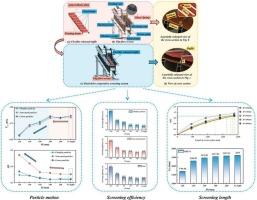Improving screening efficiency: a novel dual-drive cooperative screening system based on flexible rebound baffle and vibrating flip-flow screen coupling
IF 4.6
2区 工程技术
Q2 ENGINEERING, CHEMICAL
引用次数: 0
Abstract
Screening plays a critical role in particle separation during coal processing. However, the screening efficiency of vibrating flip-flow screens (VFFSs) in processing sticky fine materials remains to be further improved. In this study, an innovative dual-drive cooperative screening system (DDCSS) is presented, which integrates flexible rebound baffles with VFFSs. The influence of the baffle installation height (H value) on the motion characteristics and screening efficiency of the materials on the screen is systematically investigated. Additionally, we explore the potential for reducing screen length through H value optimization. The findings demonstrate that the DDCSS significantly enhances screening performance through two key mechanisms: first, by increasing the utilization rate of the screen plates, and second, by intensifying the jumping motion of the materials on the screen. With the optimization of screening efficiency as the primary objective, the system attains a maximum efficiency gain of 11.01 %. Moreover, when the primary objective is to optimize the screen length, an H value of 120 mm enables the system to achieve the same screening performance as a screen length of 2624 mm without baffles, using only 64.96 % of the original screen length. This discovery offers critical insights for the enhancement of energy utilization efficiency.

提高筛分效率:一种基于柔性回弹挡板和振动转流筛耦合的新型双驱动协同筛分系统
在煤选矿过程中,筛分对颗粒分离起着至关重要的作用。然而,振动转流筛在处理粘性细碎物料时的筛分效率还有待进一步提高。本研究提出了一种新型的双驱动协同筛选系统(DDCSS),该系统将柔性回弹挡板与vffs相结合。系统研究了挡板安装高度(H值)对物料在筛上运动特性和筛分效率的影响。此外,我们探索了通过H值优化减少屏幕长度的潜力。研究结果表明,DDCSS通过两种关键机制显著提高筛分性能:一是通过提高筛板利用率,二是通过增强筛上物料的跳跃运动。该系统以优化筛分效率为主要目标,最大效率增益为11.01%。此外,当主要目标是优化筛长时,当H值为120 mm时,系统仅使用原始筛长的64.96%,就能获得与无挡板的2624 mm筛长相同的筛分性能。这一发现为提高能源利用效率提供了重要的见解。
本文章由计算机程序翻译,如有差异,请以英文原文为准。
求助全文
约1分钟内获得全文
求助全文
来源期刊

Powder Technology
工程技术-工程:化工
CiteScore
9.90
自引率
15.40%
发文量
1047
审稿时长
46 days
期刊介绍:
Powder Technology is an International Journal on the Science and Technology of Wet and Dry Particulate Systems. Powder Technology publishes papers on all aspects of the formation of particles and their characterisation and on the study of systems containing particulate solids. No limitation is imposed on the size of the particles, which may range from nanometre scale, as in pigments or aerosols, to that of mined or quarried materials. The following list of topics is not intended to be comprehensive, but rather to indicate typical subjects which fall within the scope of the journal's interests:
Formation and synthesis of particles by precipitation and other methods.
Modification of particles by agglomeration, coating, comminution and attrition.
Characterisation of the size, shape, surface area, pore structure and strength of particles and agglomerates (including the origins and effects of inter particle forces).
Packing, failure, flow and permeability of assemblies of particles.
Particle-particle interactions and suspension rheology.
Handling and processing operations such as slurry flow, fluidization, pneumatic conveying.
Interactions between particles and their environment, including delivery of particulate products to the body.
Applications of particle technology in production of pharmaceuticals, chemicals, foods, pigments, structural, and functional materials and in environmental and energy related matters.
For materials-oriented contributions we are looking for articles revealing the effect of particle/powder characteristics (size, morphology and composition, in that order) on material performance or functionality and, ideally, comparison to any industrial standard.
 求助内容:
求助内容: 应助结果提醒方式:
应助结果提醒方式:


